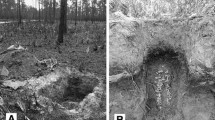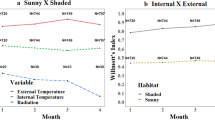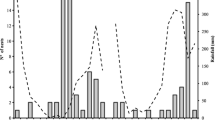Summary
In north Florida (USA), foraging and above-ground activity of the antPrenolepis imparis Say begins in November and ends in March or early April when the workers seal the nest until the following November. During this winter foraging period, workers' gasters become enormously corpulent through deposition of fat, doubling to tripling worker lean weight. The colony remains reproductively inactive until late August or early September when the queen's ovaries develop and she lays eggs. The single pulse of brood is probably reared on material derived from the corpulent workers. When the workers reopen the nests in November, most of the brood are callow workers or sexuals and all of the previous year's workers are again lean, their nutrient stores having been converted to new workers. The old workers become foragers while the callows become corpulent for the next year. Workers thus live between 1 and 2 (or more) years. Most nests are polygynous, and all queens contribute to the egg pool, though probably not equally.
The nests are 2.5 to 3.6 meters deep and consist of horizontal-floored, slightly domed chambers connected by a single vertical tunnel. As the worker population grows, total chamber floor area is increased by adding more chambers and by enlarging chambers, changing their shape from simple, nearly circular to lobed, ‘pseudopodial’ shapes. No chambers were found less than 60 cm below the ground surface, and most were in the bottom half of these deep nests, keeping most of the nest between 16 and 24° C, year-round.
Among the 9 colonies sampled, the number of workers varied from 560 to over 10,000. An incipient colony contained 33 nanitic workers and a single queen. Using the annual increase in worker population, the largest colonies were estimated to be 7 to 9 years old. Young, replete workers were found in the deeper chambers, while the previous years' workers (now foragers) were more abundant near the surface. The peculiar life cycle of this winter-active ant is discussed as an avoidance of competition with other ants by foraging during the cold season.
Zusammenfassung
Die AmeisePrenolepis imparis Say ist in Nord-Florida (USA) nur im Winter an der Erdoberfläche aktiv. Das Sammeln von Nahrung beginnt im November und endet im März oder Anfang April; danach verschließen die Arbeiterinnen das Nest bis zum November. Während der Periode des Nahrungssammelns wird die Gaster der Arbeiterinnen enorm dick, so daß das Gewicht dieser Arbeiterinnen sich verdoppelt oder verdreifacht. Die Gewichtszunahme wird durch den stark entwickelten Fettkörper verursacht und nicht durch die Füllung des Kropfes, wie man früher glaubte. Die Kolonie zieht bis Ende August oder Anfang September keine Brut auf, erst dann beginnen sich die Ovarien der Königin zu entwickeln und sie legt Eier. Diese Brut wird wahrscheinlich mit einem Sekret ernährt, für das die Energiespeicher der dicken Arbeiterinnen mobilisiert werden. Wenn die Nester im November wieder geöffnet werden, dann besteht der größte Teil der diesjährigen Brut aus jungen Arbeiterinnen oder Geschlechtstieren. Die Arbeiterinnen des Vorjahrs sind wieder mager, da sie ihre Fettkörperreserven an die Larven verfüttert haben. Diese alten Arbeiterinnen beginnen dann, Nahrung zu sammeln, während die jungen Arbeiterinnen für das nächste Jahr gemästet werden. Die Lebensdauer einer Arbeiterin beträgt also ein oder zwei Jahre oder mehr. Die meisten Nester sind polygyn, alle Königinnen sind fertil, doch legen sie vermutlich unterschiedlich viele Eier. Die Koloniegründung erfolgt wahrscheinlich pleometrotisch.
Die Nester befinden sich sehr tief im Boden, sie reichen bis zu einer Tiefe von 2.5 m bis 3.6 m. Die Kammern haben einen waagerechten Boden und eine leicht gewölbte Decke, sie sind durch einen einzigen senkrechten Gang miteinander verbunden. Die Gesamtfläche der Kammern ist mit der Arbeiterinnenzahl korreliert. Die Nester werden vergrößert, indem sowohl neue Kammern gebaut als auch vorhandene Kammern erweitert werden. Wenn Kammern vergrößert werden, dann wird die ursprüngliche Kreisform pseudopodienartig ausgelappt. Es wurden keine Kammern in einer geringeren Tiefe als 60 cm gefunden, die meisten Kammern befanden sich in der unteren Hälfte dieser tiefen Nester, wodurch im größten Teil der Nester das ganze Jahr über eine Temperatur zwischen 16° und 24° C herrscht.
Die 9 ausgegrabenen Nester enthielten zwischen 560 und über 10.000 Arbeiterinnen. Mit drei voneinander unabhängigen Bestimmungen der jährlichen Zunahme der Arbeiterinnenzahl wurde das Alter des größten Kolonie auf 7 bis 9 Jahre geschätzt. Die Arbeiterinnen waren in den Nestern spezifisch verteilt. Junge, gemästete Arbeiterinnen wurden in den tieferen Kammern gefunden, während sich die Arbeiterinnen des Vorjahrs, die jetzt Sammlerinnen waren, häufiger in der Nähe der Oberfläche aufhielten. Es wird diskutiert, daß die Lebensweise dieser kryophilen Ameise und speziell das Nahrungssammeln während der kalten Jahreszeit die Konkurrenz mit anderen Ameisen mindert.
Similar content being viewed by others
References
Brian M.V., 1983. —Social Insects: Ecology and Behavioral Biology, Chapman and Hall, NY.
Dennis C.A., 1941. — Some notes on the nest of the ant,Prenolepis imparis Say.Ann. Entomol. Soc. Am., 34, 83–86.
Headley A.E., 1949. — A population study of the antAphaenogaster fulva ssp.aquisa Buckley.Ann. Entomol. Soc. Am., 42, 265–272.
Kondoh M., 1968. — Bionomic studies on the colony of an ant species,Formica japonica Motschulsky. I. Nest structure and seasonal change of the colony members.Jap. J. Ecol., 18, 124–133.
Kondoh M., 1968. — Bionomic studies on the colony of an ant species,Formica japonica Motschulsky. 2. Allometric study of the body weight and the corpulency relating to the body size of workers.Jap. J. Ecol., 18, 171–179.
Lavigne R.J., 1969. — Bionomics and nest structures ofPogonomyrmex occidentalis (Hymenoptera: Formicidae).Ann. Entomol. Soc. Am., 62, 1166–1175.
Mirenda J., Vinson S.B., 1981. — Division of labour and specification of castes in the red imported fire ant,Solenopsis invicta Baren.Animal. Behav., 29, 410–420.
Moser J.C., 1963. — Contents and structure ofAtta texana nest in summer.Ann. Entomol. Soc. Am., 56, 286–291.
Porter S.D., Jorgenson C.D., 1981. — Foragers of the harvester ant,Pogonomyrmex owyheeis: a disposable caste?Behav. Ecol. Sociobiol., 9, 247–256.
Talbot M., 1943a. — Population studies of the ant,Prenolepis imparis Say.Ecology, 24, 31–34.
Talbot M., 1943b. — Response of the antPrenolepis imparis Say to temperature and humidity changes.Ecology., 24, 345–352.
Talbot M., 1945. — Population studies of the ant,Myrmica schencki ssp.Emeryana Forel.Ann. Entomol. Soc. Am., 38, 365–372.
Talbot M., 1940. — The slave-making antFormica sanguinea subintegrata Emery, its raids, nuptial flights and nest structure.Ann. Entomol. Soc. Am., 33, 560–577.
Talbot M., 1948. — A comparison of two ants of the genusFormica.Ecology., 29, 316–325.
Wheeler W.M., 1910. —Ants: Their structure, behavior and development, Colombia Univ. Press.
Wheeler W.M., 1930. — The antPrenolepis imparis Say.Ann. Entomol. Soc. Am., 23, 1–26
Wilson E.O., 1971. —The Insect Societies, Belknap Press, Harvard.
Author information
Authors and Affiliations
Rights and permissions
About this article
Cite this article
Tschinkel, W.R. Seasonal life history and nest architecture of a winter-active ant,Prenolepis imparis . Ins. Soc 34, 143–164 (1987). https://doi.org/10.1007/BF02224081
Received:
Accepted:
Issue Date:
DOI: https://doi.org/10.1007/BF02224081




